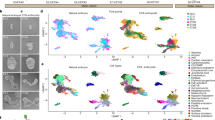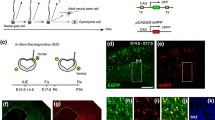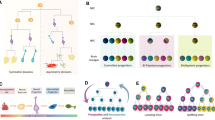Abstract
Analyzing the impact of genetic mutations on early neurogenesis of mammalian embryos in conventional mouse mutant models is laborious and time-consuming. To overcome these constraints and to fast-track the phenotypic analysis, we developed a protocol that harnesses the amenability of engineering genetic modifications in embryonic stem cells from which mid-gestation mouse chimeras and in vitro neuruloids are generated. These stem cell-based chimera and neuruloid experimental models allow phenotyping at early developmental time points of neurogenesis.
Access this chapter
Tax calculation will be finalised at checkout
Purchases are for personal use only
Similar content being viewed by others
References
Hall B, Limaye A, Kulkarni AB (2009) Overview: generation of gene knockout mice. Curr Protoc Cell Biol Chapter 19:Unit 19.12 19.12.1–17
Papathanasiou S, Markoulaki S, Blaine LJ et al (2021) Whole chromosome loss and genomic instability in mouse embryos after CRISPR-Cas9 genome editing. Nat Commun 12(1):5855. https://doi.org/10.1038/s41467-021-26097-y
Oji A, Noda T, Fujihara Y et al (2016) CRISPR/Cas9 mediated genome editing in ES cells and its application for chimeric analysis in mice. Sci Rep 6(1):31666. https://doi.org/10.1038/srep31666
Sibbritt T, Osteil P, Fan X et al (2019) Gene editing of mouse embryonic and epiblast stem cells. In: Mouse cell culture. Springer, Cham, pp 77–95
Tam PP, Rossant J (2003) Mouse embryonic chimeras: tools for studying mammalian development. Development 130(25):6155–6163
Eckardt S, McLaughlin KJ, Willenbring H (2011) Mouse chimeras as a system to investigate development, cell and tissue function, disease mechanisms and organ regeneration. Cell Cycle 10(13):2091–2099
Poueymirou WT, Auerbach W, Frendewey D et al (2007) F0 generation mice fully derived from gene-targeted embryonic stem cells allowing immediate phenotypic analyses. Nat Biotechnol 25(1):91–99. https://doi.org/10.1038/nbt1263
Rossant J, Tam PP (2021) Opportunities and challenges with stem cell-based embryo models. Stem Cell Rep 16(5):1031–1038
Bérenger-Currias NM, Mircea M, Adegeest E et al (2022) A gastruloid model of the interaction between embryonic and extra-embryonic cell types. J Tissue Eng 13:20417314221103042
McMahon R, Sibbritt T, Aryamanesh N et al (2021) Loss of Foxd4 impacts neurulation and cranial neural crest specification during early head development. Front Cell Dev Biol 9:777652
Iacovino M, Bosnakovski D, Fey H et al (2011) Inducible cassette exchange: a rapid and efficient system enabling conditional gene expression in embryonic stem and primary cells. Stem Cells 29(10):1580–1588
Greil F, Moorman C, van Steensel B (2006) DamID: mapping of in vivo protein–genome interactions using tethered DNA adenine methyltransferase. Methods Enzymol 410:342–359
Kim DI, Jensen SC, Noble KA et al (2016) An improved smaller biotin ligase for BioID proximity labeling. Mol Biol Cell 27(8):1188–1196
Niakan KK, Schrode N, Cho LT et al (2013) Derivation of extraembryonic endoderm stem (XEN) cells from mouse embryos and embryonic stem cells. Nat Protoc 8(6):1028–1041
Conner DA (2001) Mouse embryo fibroblast (MEF) feeder cell preparation. Curr Protoc Mol Biol 51(1):23.2.1–23.2.7
Masamsetti VP, Tam PP (2022) Identification and visualization of protein expression in whole mouse embryos by immunofluorescence. In: Epiblast stem cells. Springer, New York, pp 39–45
Adikusuma F, Pfitzner C, Thomas PQ (2017) Versatile single-step-assembly CRISPR/Cas9 vectors for dual gRNA expression. PLoS One 12(12):e0187236
Author information
Authors and Affiliations
Corresponding author
Editor information
Editors and Affiliations
Rights and permissions
Copyright information
© 2024 The Author(s), under exclusive license to Springer Science+Business Media, LLC, part of Springer Nature
About this protocol
Cite this protocol
McMahon, R., Masamsetti, V.P., Tam, P.P.L. (2024). Phenotypic Analysis of Early Neurogenesis in a Mouse Chimeric Embryo and Stem Cell-Based Neuruloid Model. In: Dworkin, S. (eds) Neurobiology. Methods in Molecular Biology, vol 2746. Humana, New York, NY. https://doi.org/10.1007/978-1-0716-3585-8_14
Download citation
DOI: https://doi.org/10.1007/978-1-0716-3585-8_14
Published:
Publisher Name: Humana, New York, NY
Print ISBN: 978-1-0716-3584-1
Online ISBN: 978-1-0716-3585-8
eBook Packages: Springer Protocols




